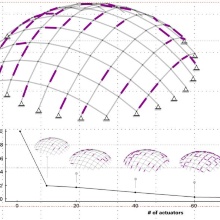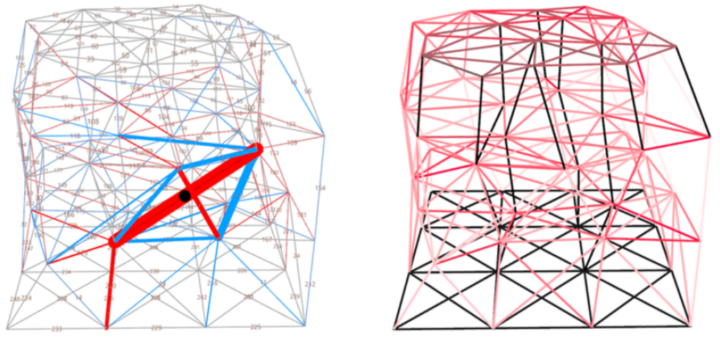Funding Phase II
Classical form finding of thin-walled structures is based on one dominant, shape-determining load case. Adaptive structures, however, offer the potential to provide an optimal shape not only for a single load case, but to always be able to adjust the ideal shape for a multitude of variable load cases. Form finding becomes form variety finding. The subproject combines methods of structural analysis and design with concepts for the concrete constructive realization of adaptive structures within the framework of a holistic view as an active system.
In the first funding period, it was shown that abstract quality measures can be derived from redundancy matrices – special structure-describing matrices that quantify the distribution of redundancies in structures – which help to assess their adaptability. They will be extended to plate and shell structures as well as geometrically nonlinear and dynamic problems in the second funding period. In reversal of analysis, inverse design concepts will be developed on this basis, with which matrices for load-bearing structures with desired properties and, from these, the load-bearing structures themselves can be derived.
In extending conventional form-finding methods to adaptive structures, it has been shown that the actuation concept itself is a crucial parameter for the form finding of adaptive structures. By investigating mechanisms of action of possible actuation concepts for shell structures, an eccentric manipulation by integrating actuators within a ribbed structure could be identified as a promising approach. This approach will be further developed in the second funding period for integration into form finding methods. Ribs equipped with actuators allow global manipulation of the structure even with small actuator travels. Furthermore, optimization strategies and objective functions for homogenization of stress fields and reduction of deformations will be extended by the aspects of safety against stability failure (buckling) in the second funding period.
In cooperation with subprojects A06, C02 and C07, the rib-based actuation concept will be further developed. With the help of the developed methods, example designs will be realized as functional models on a laboratory scale.
Subproject Leader
- Prof. Dr.-Ing. habil. Manfred Bischoff, Institut für Baustatik und Baudynamik
- Prof. Dr.-Ing. Lucio Blandini, Institut für Leichtbau Entwerfen und Konstruieren
Funding Phase I
Project description
„The aims of this project are the advancement of methods for shape finding and optimization of adaptive structures as well as their application to the Stuttgart SmartShell. The key innovative aspect is a holistic system optimization of adaptive structures (as opposed to an a posteriori 'optimal' adaptation of initially passive structures). Consequently, the notion of optimization of system behavior via adaptation has to be clearly distinguished from optimization of an adaptive system as a whole. The potential for manipulation of a given structure via adaptation of forces, displacements and stiffness is an intrinsic system property, which has not been systematically investigated up to now. As a prototype of an adaptive thin-walled structure, the Stuttgart SmartShell offers the unique possibility to experimentally support and validate the newly developed methods.“
Source: https://gepris.dfg.de/gepris/projekt/324661605?language=en
Form finding for adaptive structures
Shape finding or form finding in structural mechanics is known as an inverse problem, where the internal forces or stresses are prescribed while the shape to satisfy equilibrium is computed. Well-established form finding methods assume one shape-determining load case, which is usually the self-weight of the structure. Methods for form finding w.r.t. multiple load cases or adaptive systems are not sufficiently researched. This is one aim of research within this subproject are. Furthermore, the extension of existing form finding methods to holistic system finding methods is approached.
So far, a non-linear method based on classical force density method was extended such, that shapes of adaptive spatial truss structures under multiple static loads may be computed taking additional design constraints into account.
Regarding the extension to system finding methods the so-called disturbance-compensability matrix was developed in cooperation with control engineers from Institute of System Dynamics (ISYS) of University of Stuttgart (Wagner et al. (2018)). This matrix is a special Gramian matrix independent of load cases that describes the system inherent properties of a structure to be adapted w.r.t. its states (like forces or displacemets). On this basis, a greedy algorithm for actuator placement in adaptive truss structures is developed. Studies on exemplary truss structures revealed that the optimal compensability of internal forces is reached, if the number of serial actuators is equal to the degree of statical indeterminacy of the structure n and all statical indeterminate structural parts are adapted. Additional actuators does not have any more further effect on the compensability, because the image space of the corresponding disturbance-compensability matrix is of dimension n (Wagner et al. (2018)).
Optimization methods for adaptive systems
Regarding analytical and numerical methods a sharp distinction between form finding and shape optimization is not possible. Form finding tasks may be formulated as mathematical optimization problems. Within a cooperation with the Institute Engineering and Numerical Mechanics (ITM) of University of Stuttgart a parametric model order reduction method for geometrically parametrized systems was developed and applied for efficient shape optimization of an adaptive bridge structure (Fröhlich et al. (2019)).
A crucial hypothesis in optimized design of adaptive structures is the following: The optimization of an adaptive structures is principally superior to the adaptation of a priorly optimized passive structure. This hypothesis was verified by means of analytical investigations and numerical studies (Geiger et al. (IFAC, 2020)).

Moreover, design and optimization strategies concerning mass saving potential were evolved (Geiger et al. (BB14, 2020); Geiger et al. (Frontiers, 2020)). Significant mass savings may be realised if displacement constraints are decisive for the structural design (so-called stiffness-governed problems).
Criteria for system optimization of adaptive structures
Within this subproject area the advancement of criteria for optimal shapes and topologies of adaptive structures is focused. In the sense of an holistic system optimization the adaptive structure is considered as an entire system consisting of structure, sensors, and actuators.
So far, approaches from control engineering are focused and the above-mentioned disturbance-compensability matrix was studied. A meaningful interpretation of modal properties of the matrix from structural mechanics as well as from control engineering point of view was found in order to gain a deeper understanding of the developed actuator placement algorithm (Wagner et al. (2019)).
Furthermore, the redundancy concept (von Scheven et al. (2020); Geiger et al. (BB14, 2020)) was focused. Based on the analysis of algebraic spaces of redundancy matrices, scalar-valued performance criteria for the adaptability of force states under static behaviour were derived. Afterwards, in a cooperation with the Institute of Computational Design and Construction (ICD) of University of Stuttgart, such criteria were implemented into an agent-based system for explorative generation of adaptive truss structures.
Publications
BENJAMIN FRÖHLICH, JAN GADE, FLORIAN GEIGER, MANFRED BISCHOFF AND PETER EBERHARD. Geometric element parameterization and parametric model order reduction in finite element based shape optimization. Computational Mechanics, 63. 2019. DOI: 10.1007/s00466-018-1626-1
JULIA LAURA WAGNER, JAN GADE, MICHAEL HEIDINGSFELD, FLORIAN GEIGER, MALTE VON SCHEVEN, MICHAEL BÖHM, MANFRED BISCHOFF AND OLIVER SAWODNY. On steady-state disturbance compensability for actuator placement in adaptive structures. at – Automatisierungstechnik, 66. 2018. DOI: 10.1515/auto-2017-0099
MALTE VON SCHEVEN, EKKEHARD RAMM AND MANFRED BISCHOFF. Quantification of the Redundancy Distribution in Truss and Beam Structures. International Journal of Solids and Structures, 2020. (under review)
FLORIAN GEIGER, JAN GADE, MALTE VON SCHEVEN AND MANFRED BISCHOFF. Optimal Design of Adaptive Structures versus Optimal Adaptation of Structural Design. Proceedings of the 21st IFAC World Congress in Berlin, 2020.
FLORIAN GEIGER, JAN GADE, MALTE VON SCHEVEN AND MANFRED BISCHOFF. Anwendung der Redundanzmatrix bei der Bewertung adaptiver Strukturen. Tagungsband zur Fachtagung Baustatik-Baupraxis 14, 2020. Link: https://elib.uni-stuttgart.de/handle/11682/10779
FLORIAN GEIGER, JAN GADE, MALTE VON SCHEVEN AND MANFRED BISCHOFF. A case study on design and optimization of adaptive civil structure. Frontiers in Built Environment, 2020. Link: https://www.frontiersin.org/articles/10.3389/fbuil.2020.00094/abstract, DOI: 10.3389/fbuil.2020.00094
Subproject Leader
- Prof. Dr.-Ing. habil. Manfred Bischoff, Institute for Structural Mechanics
- Prof. Dr.-Ing. Dr.-Ing. E. h. Dr. h. c. Werner Sobek, Institute for Lightweight Structures and Conceptual Design
Publications
- A. P. Reksowardojo, G. Senatore, M. Bischoff, and L. Blandini, “Design and Control Benchmark of Rib-Stiffened Concrete Slabs Equipped with an Adaptive Tensioning System,” Journal of Structural Engineering, vol. 150, Art. no. 1, Jan. 2024, doi: 10.1061/jsendh.steng-12320.
- L.-M. Krauß et al., “Baustatische Methoden für Entwurf, Auslegung und Betrieb adaptiver Tragwerke,” in Berichte der Fachtagung Baustatik – Baupraxis 15, 04. und 05. März 2024, Hamburg, B. Oesterle, A. Bögle, W. Weber, and L. Striefler, Eds., 2024, pp. 101–108. doi: 10.15480/882.9247.
- J. Gade, F. Geiger, R. Kemmler, and M. Bischoff, “A form-finding method for adaptive truss structures subject to multiple static load cases,” International Journal of Space Structures, Jan. 2024, doi: 10.1177/09560599231212707.
- L.-M. Krauß et al., “Berichte der Fachtagung Baustatik – Baupraxis 15 : 04. und 05. März 2024, Hamburg.” Institut für Baustatik, Technische Universität Hamburg, 2024. doi: 10.15480/882.9247.
- A. Trautwein, T. Prokosch, G. Senatore, L. Blandini, and M. Bischoff, “Analytical and numerical case studies on tailoring stiffness for the design of structures with displacement control,” Frontiers in Build Environment, pp. 1–14, May 2023, doi: https://doi.org/10.3389/fbuil.2023.1135117.
- A. Trautwein, T. Prokosch, and M. Bischoff, “A CASE STUDY ON TAILORING STIFFNESS FOR THE DESIGN OF ADAPTIVE RIB-STIFFENED SLABS,” in 10th ECCOMAS Thematic Conference on Smart Structures and Materials, Dept. of Mechanical Engineering & Aeronautics University of Patras, 2023. doi: 10.7712/150123.9821.444802.
- J. Gade, A. Tkachuk, M. von Scheven, and M. Bischoff, “A continuum-mechanical theory of redundancy in elastostatic structures,” International Journal of Solids and Structures, vol. 226-227, 2021, doi: 10.1016/j.ijsolstr.2021.01.022.
- M. Böhm et al., “Input modeling for active structural elements – extending the established FE-Workflow for modeling of adaptive structures,” in IEEE/ASME International Conference on Advanced Intelligent Mechatronics (AIM), Jul. 2020, pp. 1595–1600. doi: 10.1109/AIM43001.2020.9158996.
- F. Geiger, J. Gade, M. von Scheven, and M. Bischoff, “Optimal Design of Adaptive Structures vs. Optimal Adaption of Structural Design,” in IFAC-PapersOnLine, IFAC World Congress 2020, 11.-17.07.2020, Berlin, Germany, 2020, pp. 8363–8369. doi: 10.1016/j.ifacol.2020.12.1604.
- M. Böhm et al., “Modellierung aktiver Strukturelemente als Erweiterung zum klassischen Workflow der FE-Analyse,” in Manfred Bischoff, Malte von Scheven, Bastian Oesterle (Hrsg.) Berichte der Fachtagung Baustatik – Baupraxis 14, 23. und 24. März 2020, Universität Stuttgart, Institut für Baustatik und Baudynamik, Universität Stuttgart, 2020. doi: 10.18419/opus-10762.
- F. Geiger, J. Gade, M. von Scheven, and M. Bischoff, “Anwendung der Redundanzmatrix bei der Bewertung adaptiver Strukturen,” in Manfred Bischoff, Malte von Scheven, Bastian Oesterle (Hrsg.) Berichte der Fachtagung Baustatik – Baupraxis 14, 23. und 24. März 2020, Universität Stuttgart, 2020, pp. 119–128. doi: 10.18419/opus-10762.
- B. Fröhlich, F. Geiger, J. Gade, M. Bischoff, and P. Eberhard, “Model order reduction of coupled, parameterized elastic bodies for shape optimization,” in IUTAM Symposium on Model Order Reduction of Coupled Systems, May 22–25, 2018, Stuttgart, 2018, pp. 151–163. doi: 10.1007/978-3-030-21013-7_11.
- J. Gade, M. Bischoff, and R. Kemmler, “Advanced approaches for analysis and form finding of membrane structures with finite elements, Part I: Comparison of a microstructural model with an anisotropically hyperelastic model gained by inverse problems of parameter identification,” in K. Bletzinger, E. Onate, B. Kröplin (Eds.) Proceedings of VIII International Conference on Textile Composites and Inflatable Structures (STRUCTURAL MEMBRANES 2017), 9-11 October 2017. Munich, Germany, 2017.
- J. Gade, “Einbettung eines kinematischen Mikrostrukturmodells zur Beschreibung der Werkstoffeigenschaften von Gewebemembranen in Finite-Elemente-Analysen,” Masterarbeit. Fachgebiet Statik, Institut für Statik und Konstruktion, Technische Universität Darmstadt, 2016.
- J. Gade, “Modellbildung für die Rahmenecke integraler Brücken mithilfe der Methode der Finiten Elemente,” Bachelorarbeit. Fachgebiet Massivbau, Institut für konstruktiven Ingenieurbau, Universität Kassel, 2013.
Contact
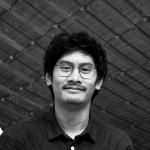
Arka Prabhata Reksowardojo
Dr.-Ing.Research Assistant
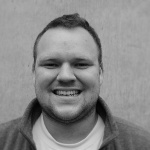
Axel Trautwein
M.Sc.Doctoral Researcher
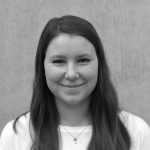
Lisa-Marie Krauß
M. Sc.Doctoral Researcher


